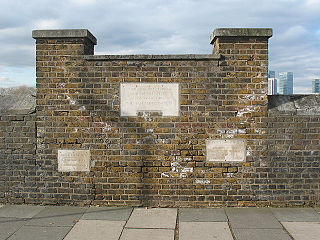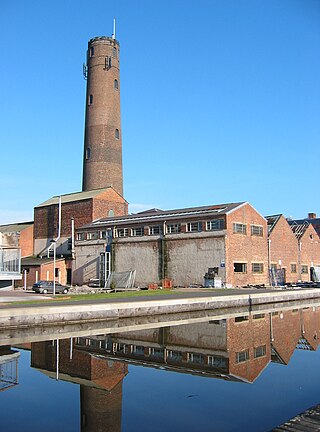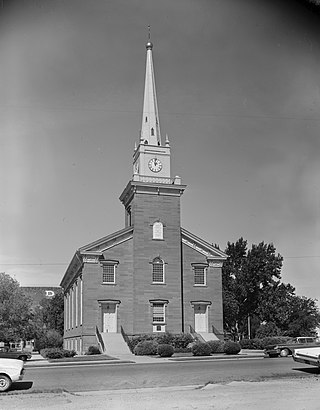
The Tower Subway is a tunnel beneath the River Thames in central London, between Tower Hill on the north bank of the river and Vine Lane on the south. In 1869 a 1,340-foot-long (410 m) circular tunnel was dug through the London clay using a cast iron circular shield independently invented and built by James Henry Greathead, similar to an idea that had been not received a patent in 1864, nor built by Peter W. Barlow.

Waterloo Bridge is a road and foot traffic bridge crossing the River Thames in London, between Blackfriars Bridge and Hungerford Bridge and Golden Jubilee Bridges. Its name commemorates the victory of the British, Dutch and Prussians at the Battle of Waterloo in 1815. Thanks to its location at a strategic bend in the river, the bridge offers good views of Westminster, the South Bank and the London Eye to the west, and of the City of London and Canary Wharf to the east.

Rumelihisarı or Boğazkesen Fortress is a medieval Ottoman fortress located in Istanbul, Turkey, on a series of hills on the European banks of the Bosphorus. The fortress also lends its name to the immediate neighborhood around it in the city's Sarıyer district.

The Cape May Lighthouse is a lighthouse located in the U.S. state of New Jersey at the tip of Cape May, in Lower Township's Cape May Point State Park. It was built in 1859 under the supervision of U.S. Army engineer William F. Raynolds, was automated in 1946, and continues operation to this day.

The Queen Elizabeth Hall (QEH) is a music venue on the South Bank in London, England, that hosts classical, jazz, and avant-garde music, talks and dance performances. It was opened in 1967, with a concert conducted by Benjamin Britten.

Grimsby Dock Tower is a hydraulic accumulator tower and a maritime landmark at the entrance to the Royal Dock, Grimsby, in North East Lincolnshire, England. It was completed on 27 March 1852, based on William Armstrong's idea of the hydraulic accumulator, with the purpose of containing a 30,000-imperial-gallon (140,000 L) reservoir at a height of 200 feet (61 m), that was used to provide hydraulic power to power the machinery of the Grimsby Docks. The extreme height of the tower was necessary to achieve sufficient pressure, and as a result of this, the tower can be seen for several miles around, even far inland on the north bank of the Humber estuary in villages such as Patrington.

The Brunel Museum is a small museum situated at the Brunel Engine House, Rotherhithe, London Borough of Southwark. The Engine House was designed by Sir Marc Isambard Brunel as part of the infrastructure of the Thames Tunnel which opened in 1843 and was the first tunnel to be built under a navigable river anywhere in the world. It comprises the Engine House and the Tunnel Shaft, with rooftop garden. Isambard Kingdom Brunel worked with his father on the project from 1823 and was appointed Resident Engineer in January 1827 at the age of 20.

The Museum of the Moving Image (MOMI) was a museum of the history of cinema technology and media sited below Waterloo Bridge in London. It was opened on 15 September 1988 by Prince Charles and at the time, was the world's largest museum devoted entirely to cinema and television. The museum formed part of the cultural complex on the South Bank of the River Thames. MOMI was mainly funded by private subscription and operated by the British Film Institute. MOMI was closed in 1999, initially on a supposedly temporary basis, and with the intention of its being relocated to Jubilee Gardens nearby. Its permanent closure was announced in 2002.

John Webb’s or Lowe’s Mill is a Grade II* listed tower mill at Thaxted, Essex, England, which had been restored to working order, but is currently out of action following the loss of a sail in April 2010.

Thomas Hill Standpipe, which holds 1,750,000 US gallons (6,600,000 L) of water, is a riveted wrought iron tank with a wood frame jacket located on Thomas Hill in Bangor, Maine, United States. The metal tank is 50 feet (15 m) high and 75 feet (23 m) in diameter. Built in 1897, it is an architecturally distinctive city landmark, and was listed on the National Register of Historic Places in 1974.

The 1928 Thames flood was a disastrous flood of the River Thames that affected much of riverside London on 7 January 1928, as well as places further downriver. Fourteen people died and thousands were made homeless when floodwaters poured over the top of the Thames Embankment and part of the Chelsea Embankment collapsed. It was the last major flood to affect central London, and, along with the disastrous North Sea flood of 1953, helped lead to the implementation of new flood control measures that culminated in the construction of the Thames Barrier in the 1970s.

Chester Shot Tower, also known as Boughton Shot Tower, is a grade-II*-listed shot tower located at SJ413667 in the Boughton district of Chester, England. The tower stands beside the Shropshire Union Canal and forms part of the disused Chester Leadworks. Built by Walkers, Parker & Co. in 1799, the tower is the oldest of three remaining shot towers in the UK, and probably the oldest such structure still standing in the world.

Gainsford End Mill is a grade II listed tower mill at Gainsford End, near Toppesfield, Essex, England, which has been converted to a residence.
Lannock Mill is a Grade II listed tower mill at Weston, Hertfordshire, England which is derelict.

The Water Tower is a 14th-century tower in Chester, Cheshire, England, which is attached by a spur wall to Bonewaldesthorne's Tower on the city walls. The tower, together with its spur wall, is recorded in the National Heritage List for England as a designated Grade I listed building. The original name of the tower was New Tower but in the 17th century it became known as the Water Tower, although the City Assembly tried to insist on the usage of its correct name.

The St. George Tabernacle is a historic building in St. George, Utah. It opened in 1876 to serve as a public works building, originally hosting church services and court hearings. Today, it is open to the public and hosts many public events, such as concerts.

Old Christ Church is a redundant Anglican church located in Waterloo Road, Waterloo, Merseyside, England. The church is recorded in the National Heritage List for England as a designated Grade II* listed building, and is under the care of the Churches Conservation Trust. It was declared redundant in 1982, and its functions have been replaced by a new Christ Church at the junction of Crosby Road South and Alexandra Road, Waterloo.

Camberley Obelisk is a brick tower at the top of a hill in Camberley, Surrey, England. The tower was built by John Norris (1721–1786) in about 1765–1770. The top section of the tower was destroyed by fire in the early 1880s. It is a Grade II listed building.

The Prince of Wales Tower is the oldest martello tower in North America and is located in Point Pleasant Park, Halifax Regional Municipality, Nova Scotia, Canada. It was built in 1796 by Captain James Straton and was used as a redoubt and a powder magazine. Restored, it was designated a National Historic Site of Canada in 1943.

The Hayward Gallery is an art gallery within the Southbank Centre in central London, England and part of an area of major arts venues on the South Bank of the River Thames. It is sited adjacent to the other Southbank Centre buildings and also the National Theatre and BFI Southbank repertory cinema. Following a rebranding of the South Bank Centre to Southbank Centre in early 2007, the Hayward Gallery was known as the Hayward until early 2011.




















